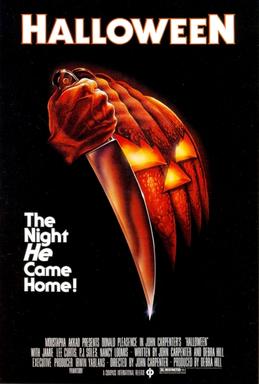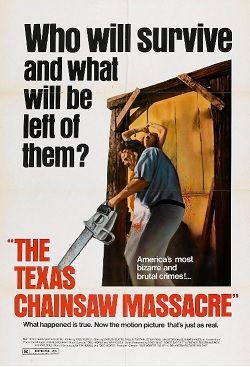From Butcher Knives to Parasites
Abbie Steuhm traces humanity’s fears through the horror film genre (or what we may feel we are living now).

As long as human beings have something to fear, the horror genre will almost never run out of material. Horror in itself appears rather contradictory; it illustrates the audience’s fears in intense and graphic scenarios, but the audience nevertheless returns to the theater to re-experience what is believed to be a negative emotion.
Since the silent era, horror films have been used as a way to conquer fears that plagued society at the time. The vampiric monster Dracula represented the fear of sexuality but was ultimately turned to ash in the end. Often times, these fears that are shown in the horror genre are shared and reciprocated among the masses, or what notable film theorist Thomas Schatz describes as “the community”. In eighties slasher films, it is the chaotic and individualistic serial killer who infiltrates the home where the community resides; this fear of someone breaking away and attacking the community can be seen in many classic horror films.
However, the horror genre has recently flipped the script in that now it is the community—or society itself—that poses the threat, much to the viewers’ dismay. In particular, the films of South Korean director Bong Joon-ho are the ones leading this evolution of the genre with The Host (2006) and Parasite (2019) at the helm of it all. It is with these two movies that the fears of poverty, hunger, and disease are explored, illustrating how some of humanity’s most archaic fears are addressed within the twenty-first century. With the recent outbreak of COVID-19, movies like The Host are revisited due to its exploration of the fear of disease within a modern city, revealing how the same fears reappear but within different contexts.
Both of Bong Joon-ho’s films prove to be timeless despite the ever-changing times primarily due to their topic of the wealthy and powerful against the poor, striking fear into the viewers as they witness class inequality conquer any and all efforts made by those in poverty, the underdog community both destroying and being destroyed by the powerful one. Parasite illuminates this new change in the horror film genre by utilizing other genres such as comedy and realism to expand upon society’s latest fear: the destruction of the community itself.
Film theorist Thomas Schatz states that every genre revolves around a theme of the community versus the individual; films then address “basic cultural conflicts” in which “all film genres represent the filmmakers’ and audience’s cooperative efforts to “tame” those beasts… which threaten the stability of our everyday lives” (571). However, while genres like musicals and comedies “celebrate the values of social integration”, and Westerns and gangster films “uphold the values of social order” (Schatz 571), the horror genre utilizes cultural conflicts to instead show the consequences of social segregation and failure to maintain social values.

In Halloween (Carpenter 1978), Jamie Lee Curtis’ character maintains the social values of a responsible babysitter, while her friend fails to do so when she invites her boyfriend over, opening the literal door to the house (a classic symbol for community and family) for the socially segregated Michael Myers (Nick Caster) who then viciously murders the couple as consequence for his own segregation from society and for the couple’s failure in being responsible teens while the parents are away. The horror genre is therefore an ideologically based genre. The semantic elements (e.g. setting, characters, iconography) may differ depending on the filmmaker’s artistic preferences, but the overarching themes (almost) always relate back to fearing the consequences of not upholding community values and/or social segregation.
Unlike the classic Western genre with its lone rangers and frontier takeovers, the definition of a horror genre is rather abstract. Bruce F. Kawin states in his book Horror and the Horror Film, that horror is “defined by its recurring elements…by its attitudes toward those elements… and by its goal: to frighten and revolt the audience” (4). On the other hand, Stephen Prince states in a collection of essays titled The Horror Film, that the genre differentiates itself not through “degree of popular appeal” or “social symbolism”, but through its exploration of human existence and anxiety by asking the question “What must be done to remain human?” (3). Nonetheless, what can be agreed upon is the horror genre’s utilization of common anxieties and fear to create an endless number of monsters and narratives. For example, many slasher movies from the eighties showcase middle-class, babysitting teenagers who are later mutilated during a make-out session by the sexually repressed killer, illustrating and grotesquely exaggerating the parents’ fear of leaving their sexually budding children home alone during the conservative Reagan-era America.
Despite its well-known elements of fear-related themes, monstrous villains, and cozy, but creepy houses, the horror genre continues to be broad and loosely-defined; however, this allows for filmmakers to revise horror films in a multitude of ways. One of the most critically acclaimed and popular movies of the year Parasite (Joon-Ho 2019) demonstrates the far-reaching boundaries of the horror genre.
Parasite tells the story of the destitute Kim family living in a semi-basement apartment when the family’s son Ki-woo (Woo-shik Choi) gets a job as the wealthy Kim family’s tutor. Soon, the Kim family has unknowingly hired the entire Kim family as their servants. The first half of the movie presents itself as a comedic heist film; the audience laughs as the Kim parents praise their daughter’s forgery skills and practice acting out fake backstories about how they know their own son, all so they can get jobs and be able to eat a proper dinner. However, not every moment of a horror film “has to be shocking. Many of the best scenes… are subtle”, in which “much of the art of the horror film has developed as a means of suggesting… what might be hidden in the shadows” (Kawin 7). This can be seen in Parasite when the scholar’s rock is first introduced; director Bong Joon-ho states in an interview with Polygon reporter Karen Han that “In the movie, that this young guy is giving it as a gift is a strange thing… the actor outright says it’s a symbol, so it’s even weirder.”
The main plot of Parasite begins with an abnormal gift that sets a mysterious and confusing tone that underlines the entirety of the movie, much like how in Halloween when the main character Laurie (Jamie Lee Curtis) is introduced during a class where the teacher sharply spits out a lesson about fate, producing an unsettling tone. The scholar’s rock in Parasite later grants the audience catharsis—despite its proclaimed status as being “metaphorical”—when it is used as a literal weapon, unveiling the earlier mystery to reveal the horrific climax of the film.
The stark contrast in settings in Parasite also help contribute to its horror side. The Kim family’s sub-basement apartment is surrounded by neon lights, trash-filled streets, and drunken men peeing on their window; the Park family home appears to be a whole new world by comparison with its isolated hilltop location and modern architecture, and it contains new, mysterious possibilities as well with its secret basement bunker where ex-maid Moon-gwang’s (Lee Jeong-eun) husband resides completely unknown to the Park family. The (literal) dark underbelly of the Park home creates a terrifying sense of unease, as there is not only a man living down there who controls the house’s lights (flashing them on and off to signal the young Park son, like how the “Beast” from Poltergeist (Hooper 1982) communicates with the young daughter through the television), but also Moon-gwang’s corpse. Albeit extremely subtle, Parasite proves itself to be a prime horror film, but its unorthodox methods help in revising the horror genre.
While comedy may not be an essential aspect of horror, it has still been used before with the “faces of death”. Many slasher films “create some aesthetic distancing for viewers from the physical traumas on display by placing them within a fictional frame”, often by utilizing “flamboyant death scenes” (Prince 8), producing the infamous “faces of death” where the character badly acts out the process of dying by making unintentionally funny faces. Parasite then takes those funny clichés to the next level by using tropes and elements from the comedy genre itself in its first half; however, the film then revises the “faces of death” trope. By placing all of the comedy in the first half, the audience is so distanced from horror that when the first death occurs (Moon-gwang being comedically kicked down a flight of stairs, smashing her neck against a concrete wall), the viewers’ aesthetic distance is completely shattered leaving them horrified, the opposite effect of the “faces of death” trope. Instead of using comedy to distance the audience from the physical horror and trauma on screen, recent films like Parasite utilize comedy to draw the audience into a sense of security so that their attention will be immediately captured when the real horror begins. In an ideological genre, using comedy alongside horror also helps in conveying the film’s message.
Since the horror genre is based primarily on the ideology of the community, the genre itself is constantly evolving—sometimes it even relapses or regresses—along with people’s ideals and beliefs of their time, as shown in Parasite. While the slasher films of the eighties fitted in nicely with Schatz’s community versus the individual theme, many recent films like Parasite (see also Jordan Peele’s Us and Get Out) reverse this dynamic, making it so that it is the community, which is symbolic of society, that threatens the individual.

The horror genre has seen the destruction of the community before with Texas Chainsaw Massacre mocking the family structure by creating a family of cannibals (with one wearing a mask of human skin while cross-dressing as a woman); however, Parasite shows a new fear where the family’s destruction is inevitable, even while maintaining good familial values. Ki-woo upholds the values of family: he attains a job to support his family, and even gets each member of his family a job as well. Ki-woo goes even further and vows to actually go to a good college, so that one day he can support his family without resorting to scams. The Park family on the other hand appears as less exemplary: the father laughs at the question of whether he loves his wife (“We’ll call it love.”), the daughter believes that her seven-year-old brother is “faking” his trauma, and the mother is so lax and gullible that she allows her traumatized child to scare away tutors, claiming that it is all part of what she believes to be artistic genius. The parents even use the exact same scenario they fired their driver for (which was supposedly having sex with a drug addict) in their foreplay; the Park family maintains the appearance of high morals, but they do not actually practice them. No matter his intentions or good nature, Ki-woo and his family must still fight to the literal death to just keep their jobs in the Park family home, which ultimately leads to the destruction of the Kim family. Parasite revises the classic community versus the individual theme, where all community values are met but is still not enough to keep the Kim family safe.
As seen through the history of films from Texas Chainsaw Massacre (Hooper 1974) to Parasite (Joon-ho 2019), the horror genre has no doubt adapted to the ever-changing environment of the world becoming an ever more inclusive genre; however, due to its constantly changing nature, past horror films appear to only offer one perspective of a time in history making the genre seem rather stagnant and based solely on a specific time period. However, acknowledging the similarities between past and present beliefs and fears, and how they are presented in horror films, should not be discouraged.
Take the current pandemic of COVID-19; during a time where no one can be within six feet of each other, people find comfort in past movies such as Contagion (Soderbergh 2011), and for this particular example, Bong Joon-ho’s The Host (2006). In The Host, a reptilian monster born of the careless disposal of formaldehyde into the Han River comes back to haunt South Korean citizens, specifically the Park family, taking off with their youngest member. The remaining Park family members quickly realize that they must ban together to save their young member as the government is controlled by the American military and the South Korean public are caught in the fabricated lie of there being a contagious disease instead of an actual river monster. Much like Parasite, The Host illustrates a community that comes together to fight off a monster and rescue one of their members, only to once again fall apart as not only does the patriarch die during the film, but so does the young daughter, and the remaining members all depart from each other once again.
However, The Host primarily presents the fears of consequences from harming the environment (as exhibited in the opening scene where bottles of formaldehyde are disposed of into the Han River) and the diseases that can follow (such as the fabricated disease the American government created), specifically The Host explores how these fears affect the poor and working-class. The Host does offer a bit of optimism as the screw-up son finds redemption by taking in the orphan boy who was saved from the monster by his daughter. Despite the community being taken apart one by one, The Host offers its audience during a turbulent time some hope, where no matter what ruin people face during pandemics, they can rebuild and start again.
Now, by comparing The Host with Parasite in the context of the COVID-19 pandemic, the two films offer an insightful look into modern events despite being made months, and years, beforehand. The majority of the chaos in The Host is caused by the South Korean government with the American government overseeing them. They create the monster by poorly disposing of a ridiculous amount of formaldehyde down the drain leading to the Han River, and instead of acknowledging the monster’s existence, both governments lie about there being a contagious disease causing every working adult to wear medical masks and panic whenever someone has a coughing attack.
Yet, the South Korean people continue to go to their office jobs because ultimately the fear of disease emanates from the fear of being financially unstable. This fear of disease and instability connects The Host with Parasite, as the wealthy Park family fires their reliable housemaid Moon-gwang (who lived in the house longer than the Parks themselves) based on the concocted lie told by the Kim family in which the housemaid has tuberculosis. Moon-gwang loses her livelihood, which then leads to her losing her own life, due to a fake disease; then, the eldest son of The Host’s Park family is prevented from saving his still-breathing daughter due to being deemed as patient zero for the government’s imagined illness.
With today’s pandemic, wealthy people like Parasite’s Park family can afford a few months without a maid, but the maid him/herself cannot no matter how real or fake the disease might be. The wealthy Park family fears the fake tuberculosis due to their young son, but they simply rid themselves of the source. The Host’s poor Park family fears a literal monster, as well as the immensely real, yet somewhat invisible threat of poverty; they nevertheless continue to fight it in order to save their beloved family member. In these films, the causes of fear are the same, a member of the community is threatened, but the level of fear differs greatly. The wealthy Parks in Parasite have a short-lived fear, while the poor Parks in The Host continue to live their fear as the remaining eldest son stands watch over his snack shack with a loaded gun. These two films showcase the fear of disease and how it differs among classes and even governments, with the monster—as well as fellow coworkers—specifically going after the working-class families since they are the ones who suffer the most from sickness, medical bills, and unpaid leave.
The elements of the horror genre are produced by each film’s ideology, and each ideology changes with the times, making it the horror genre timeless and abstract. In this modern time of rent increases and stagnant wages, Bong Joon-ho’s Parasite comes about to reinvent the classic tropes of horror with a “haunted” house and secret-filled basements, but also revises the use of comedy in horror and the theme of community versus the individual. Today’s horror is not being able to pay rent, as well as the hidden gap between the wealthy and the poor. This anxiety is represented by the Kim family and their tooth-and-nail struggle just to keep working in the rich Park family home. Parasite utilizes comedy throughout its first half then to lull the audience into a new fictional world, only to shock them to attention with the death of Moon-gwang. Her death reveals the revision of the traditional theme: even if one puts their family (community) first, it is not enough to keep them safe and prosperous. Bong Joon-ho’s The Host as well as Parasite both illustrate a fear of disease, but when reconsidered in light of the COVID-19 pandemic, the severity of the fear differs among economic classes revealing an ever stronger divide between the wealthy and poor communities in relation to how each one faces this fear.
However, a severe difference remains between the two, primarily their endings. The Host was produced in the early 2000’s, a time where many doubted the harm people cause the environment, the ending proves to be hopeful as at the time there was much more hope in slowing down and even preventing climate change. The latest installment Parasite has updated the overall outlook on life to a rather grim one; as Ki-woo imagines freeing his father, the viewer is faced with him still trapped in the sub-basement apartment. As climate change gives a deadline of twelve years, and millions either gather meager unemployment checks or trudge into cramped grocery stores during a pandemic, our timer steadily ticks down, and our outcome seems to be as dim as Ki-woo’s. Many often forget about the beginnings of the horror film genre, where the community is actually restored in the end, but as the genre revises again and again such endings found in the worldwide, desolate era of the 1930’s are once again brought to the screen. Parasite does not completely belittle the cause to fight against structural injustices like economic classes, rather it gives Ki-woo’s optimism, proving there to be a spark of fight left despite the horrors of reality coming down upon us in these bleak times.

Abbie Steuhm is an English & World Literature major, focusing particularly on the relationship between literature and film. She is a member of MMC’s Cinemaniacs film club, actively producing and directing short films.

